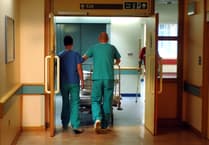A group of prominent business people have joined former town council leader John Neale in urging the Farnham Infrastructure Programme not to drop plans to pedestrianise the town.
Local authorities, organisations and pressure groups have failed over many years to agree the best way forward for the town centre.
The infrastructure programme, led by Surrey County Council, is at the consultation stage and offers the best opportunity for years for action to be taken.
But its proposals still fall short of a full pedestrianisation plan – and business people who met to discuss the proposals believe that’s a mistake and a wasted opportunity.
They also believe having a trial traffic-free town centre would help residents determine the best way forward.
A statement issued by the group to the Herald reads: “Members of key Farnham businesses and organisations met to consider the published FIP proposals for Farnham town centre.
“The intention was to provide some consolidated feedback from these organisations with such long-standing interests in the town and to help progress the project.
“At the outset we recognise the time and commitment that has gone into the plan and welcome the potential step forward these proposals represent concerning a problem that has seen little progress for too long.
“This is despite several previous attempts to address it, including a referendum on the subject in 2014.
“Consequently, we support this current plan of improving the pedestrian experience within the town (SCC Option B). However, only as a first step, albeit an important one, towards realising the more ambitious vision of a traffic-free, pedestrianised, central zone.
“Everyone at the meeting recognised the core requirement was to ensure both a commercially-vibrant and environmentally-sustainable town centre which we felt to be threatened without change.
“Street-scene improvements should add to the general attractiveness and ambience of the centre to help ensure footfall from local residents, visitors and the student population for our important retail and hospitality enterprises which provide life to the heart of the town.
“With the structural changes taking place in both these important sectors, we must aim to attract more shoppers and visitors to spend time in the town, both during daytime and the evening.
“And we must also ensure easy pedestrian connection between the traditional historic Farnham centre and the new Brightwells development.
“Over the next few years further planned growth will add traffic into an already-congested area. The need to address this challenge can be made elsewhere.
“Suffice to say that pedestrianisation, sooner rather than later, would help contribute to climate change objectives – and it was the view of the meeting that, in the end, this would become an unavoidable and urgent requirement, both economically and politically.
“We are also supportive of any measures that encourage the community to embrace cycling for those who can, both now and into the future, as well as public transport, where practical.
“Such alternatives to car use, together with promoting and facilitating behaviour change to become more physically active, should be part of the overall plan.
“A transition to the vision of a pedestrian-focused centre could also provide a powerful statement that Farnham is now adopting measures that are a meaningful step towards meeting climate change objectives.
“We recognise this is a particular concern of Farnham’s younger generations and should also be included.
“Given the current momentum created by the Farnham Infrastructure Programme, it was the view of the meeting that failing to define current proposals as just the first step towards achieving the ambition of a pedestrian heart to the town would lead to missing out once again on starting this process, despite the best of intentions.
“At the very least we would like to see this vision included as part of the proposals.
“We accept none of this is easy. Initially there are consequences to the transfer of through traffic affecting our local communities. Solutions to this must in the end be found as road traffic will increase.
“Therefore, we must continue to argue for changes to the road network – both large and small – to at least mitigate these problems, and lobby for the central government funds required.
“Major road improvements will take longer. They should not stop progress on improving the heart of Farnham now and over the next couple of years.
“We have been here before. After all, the 2014 referendum produced a narrow majority in favour of pedestrianisation.
“Consequently, we see the current proposals as a positive step, but we would also strongly urge other trials should be progressed, preferably before 2024-25, to establish the best ways to transition towards pedestrianisation.
“Actual experience would help refine solutions and encourage the process of behaviour change that will be needed by all of us in the years ahead.
“Without a defined step-by-step approach and an agreed policy to implement a vision of a traffic-free heart to our town, we remain concerned the economy of Farnham, the future of its historic conservation area and other considerations of well-being, will be compromised.
“This has happened before. Let’s not miss the opportunity again.”
The business people backing the move are:
Robert Lewis and David Lewis (Farnham Estates, property)
Maximilian Lyons (Lyons & Sleeman & Hoare, architects)
Alan Bushnell and Liz Flanagan (Elphicks department store)
John Chesterman (Bush Hotel)
Lynsey Luthra (Farnham Maltings)
Ken Kent and Nick Kent (Kents Property)
Steve Hamilton (Farnham Chamber of Commerce)
Ed Wernick (Downing Street General Practice)
Damien Blower (Farnham Architects Forum)
Matthew Elliott (FBN Properties)
Andrew Lodge (Andrew Lodge Estate Agents)
Peter Goodman (Farnham Cycle Campaign)
Councillor John Neale, who convened the meeting.



